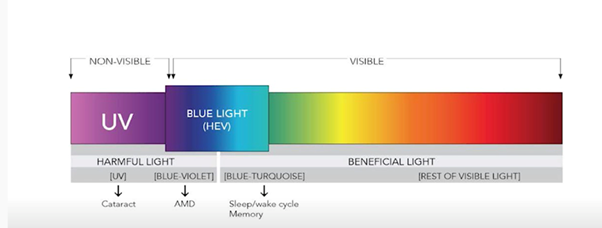Got the blue light blues?
Many of us spend the bulk of our day staring at digital screens and most screens emit blue light. Reading this article means there’s a good chance you’re looking at one right now. GMHBA Clinical Manager Amanda Kammerer takes us through what blue light is, how it can impact on your health and what you can do to control it.
What is blue light?
Light visible to the human eye is made up the colours red, orange, yellow, green, blue, indigo and violet. These colours vary in wavelength and frequency. The blue, indigo and violet lights are higher frequency and energy. Studies suggest that over time, exposure to these high energy blue lights could cause both short and long-term damage to your eyes.

Image source http://www.bluelightexposed.com/#what-is-bue-light
Fluorescent and LED lights as well as LED screens found in televisions, computers and mobile phones emit high amounts of blue light. It is the blue light from devices held close to the eye that is most likely to cause eye strain and retinal damage due to their proximity to the eye.
Blue light and your health
Higher energy blue light flickers more than longer wavelengths of light. This flickering creates a glare that can reduce contrast and affect clarity. Blue light can cause:
- Sleep disturbance
- Eyestrain
- Headaches
- Physical and mental fatigue
- Eye damage
Our natural eye filters don’t provide enough protection against blue light rays. Prolonged exposure to blue light may cause retinal damage and contribute to age-related macular degeneration, which can lead to permanent loss of vision. Chronic exposure to blue light has also been shown to have detrimental effects on our general health and disturb regular sleep patterns.
Ways to manage blue light exposure
Exposure to blue light can be reduced with a coating on spectacle lenses that blocks the blue light. This can be applied to spectacles for everyday or simply ones designed for computer and screen use.
Blue light filters can also be applied to specific screens that are used. These options can help you relieve digital eye strain.
Other top tips for protecting your eyes
- Work at a comfortable distance – keep screens at about arms distance away and don’t get too close with books and phones.
- Follow the 20/20/20 rule – take a break every 20 minutes, even if it’s just 20 seconds to look around the room at objects at 20 feet away or more.
- Spend an hour outside every day – sunlight and distance vision are good for the eyes, and for overall health and wellbeing too.
For more Information
Your optometrist is the best health professional to go to for regular eye health checks and to answer your questions about blue light and ways to manage it.



